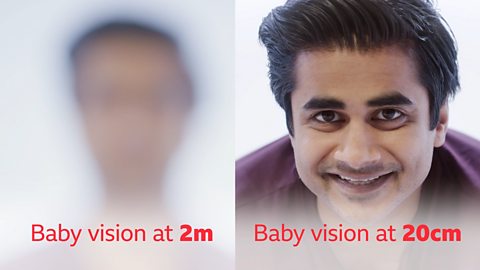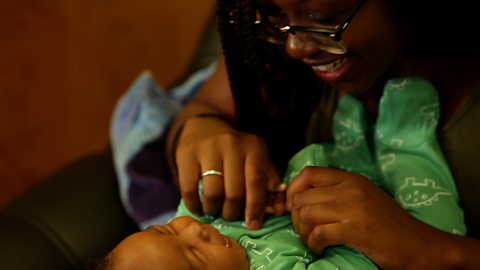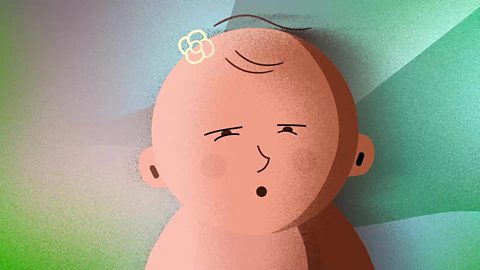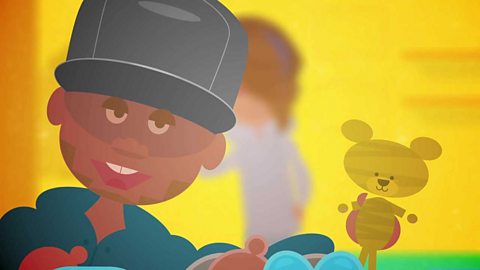Have you ever wondered what your baby can actually see in their first few months?
When babies are born, they can't see more than twenty centimeters in front of them. This means that they struggle to hold their attention on things that happen far away from their face.
This limited scope of vision greatly affects their early communication and language skills. So as a parent, what's the best way to adapt to your baby's vision?
Professor Ben Ambridge is answering this question in our Speech Lab. Watch the full video to discover how babies react differently to interactions close up and far away.
Ben
Right from birth, babies love faces - especially when you're up nice and close but have you ever wondered; what can they actually see in those first few months and why is watching your mouth and hand movements so important for early language development? To find out, let's investigate baby vision.
Ben
So how old is Ari now?
Dad
So Ari's going to be two months this Sunday.
Ben
And have you noticed him watching you when you get up close?
Dad
Yeah, so I like to get really up and close to him when he's in the bouncer or he's sleeping in the Moses basket.
Mum
You walk around don't you, and he'll just follow you.
Ben
At this age, Ari's eyes are still developing, but he's already a little learner and he loves looking at you. To find out how much Ari can actually see we're going to test how he responds when you're up close, as compared to when you're further away. Great! So let's start with the longer distance. Let's see how much time Ari spends looking up at you when you're two metres away.
So he only looked at you for about four seconds in that one minute period. So now let's see what happens if you get closer to that twenty centimetre distance.
Dad
Hello baby!
Ben
So this time, Ari looked at you for forty-two seconds out of the minute. So that's seventy percent of the time, as opposed to just seven percent, when you were further away. Ten times more! When you were two metres away, you were too blurry for Ari to make out your mouth, hands and eyes - so he wasn't that interested. When you get up close, your baby will be able to see your mouth movements and relate them to the sounds that you're making - which is really important for language development. Babies are actually born short-sighted, which is scientifically known as myopic. So up until about three months old, they can only focus on things up to twenty centimetres in front of them which is about as far as they can reach. This is because the muscles in their eyes are still developing - so can't focus the eyes lenses overlong distances, and just like any muscle these eye focusing- or ciliary muscles need training and exercise to build up strength. So between birth and about three months, it's extra important to get up close to your baby. They'll be really interested in watching your mouth movements and this is the first step for babies to learn how to make speech sounds for themselves.
Try this baby vision experiment at home
In this experiment we are comparing how babies react differently when you interact with them far away and up close.
You might need an extra adult to help with some counting when you try this experiment at home, or you could try recording your baby and watching the footage back afterwards.
Firstly, you want to measure how much time your baby spends looking at you when you're talking to them about 2 meters away. Spend one minute chatting to your baby from this distance and take note of how often they look at you in this time.
You could try having a chat about your day or singing a nursery rhyme.
Next, chat to your baby for another sixty seconds while you're much closer to them. Try standing about twenty centimeters away. Once again, measure how often your baby looks at you.
Do you notice a major difference in how often your baby looks at you when you're up close?
In our experiment we found that babies pay attention for ten times longer when parents stand closer to them.
This is probably because when you stand further away, you are too blurry for your newborn to make out your mouth, hands or eyes. So they lose interest far quicker.
Getting close to your baby is really important for their early language development. When you get up close, your baby will be able to see your mouth movements and relate them to the sounds that you're making. This is the first step on their language journey.

Why can't babies see far away?
Babies can only see a short distance in front of them up until they're about three months old.
This is because the muscles in their eyes are still developing, so they can't focus the eyes' lenses over long distances.
Just like any muscle, these eye-focusing (also known as ciliary) muscles need training and exercise to build up strength.
As they get older, their vision will start improving quickly. After three months, your baby might be able to use their eyes together to track and focus on objects more.
It's not until around six months that your baby will start to approach the 20/20 vision that adults have.
Face-to-face activities with your baby
Between birth and about three months, it's important to get up close to your baby. They'll be really interested in watching your mouth movements and this is the first step towards learning how to make speech sounds for themselves.
Below are some great activities to try with your newborn that will get you really close:
- Singing during feeds can help soothe your baby and is an early chance for them to hear words.
- Copying and repeating your baby's actions helps them build brain connections.
- Babies love looking at faces. Why not try drawing some?







